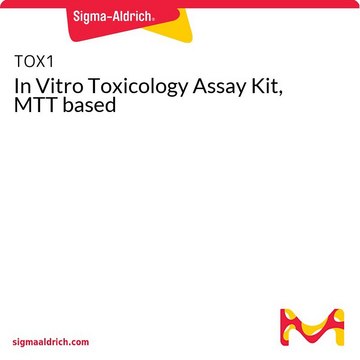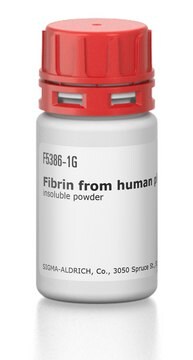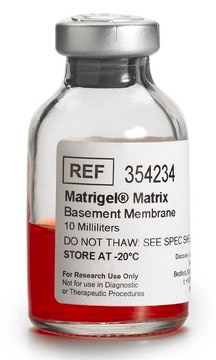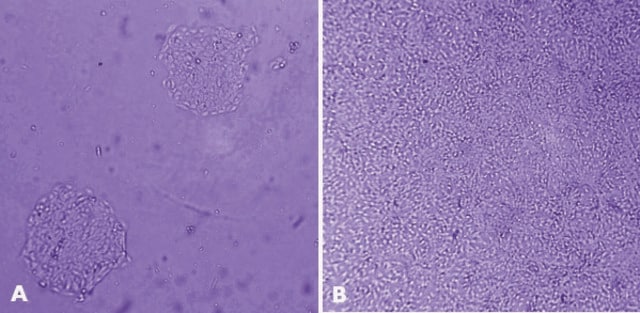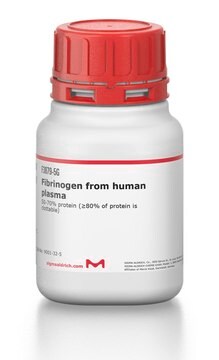ECM630
Fibrin In Vitro Angiogenesis Assay
The Fibrin Gel In Vitro Angiogenesis Assay Kit represents a simple model of angiogenesis in which the induction or inhibition of tube formation by exogenous signals can be easily monitored.
Sign Into View Organizational & Contract Pricing
All Photos(2)
About This Item
UNSPSC Code:
12161503
eCl@ss:
32161000
NACRES:
NA.84
Recommended Products
Quality Level
species reactivity
vertebrates
manufacturer/tradename
Chemicon®
technique(s)
activity assay: suitable
cell based assay: suitable
shipped in
dry ice
General description
Introduction
Angiogenesis is the process of generating new capillary blood vessels. It is a fundamental component of a number of normal (reproduction and wound healing) and pathological processes (diabetic retinopathy, rheumatoid arthritis, tumor growth and metastasis)1.
The CHEMICON Fibrin Gel In Vitro Angiogenesis Assay Kit provides a convenient system for evaluation of tube formation by endothelial cells in 96-well or other formats. When cultured on top or within a fibrin gel, endothelial cells rapidly align and form interconnecting networks that can display patent lumina2,3. Tube formation is a multi-step process involving cell adhesion, migration, differentiation and growth4. The formation of intercellular connections and lumina within endothelial cell networks in fibrin gels is dependent upon the actions of VE-cadherin, avb3 and a5b1 integrins, the cdc42 and Rac1 GTPases, and membrane-type matrix metalloproteinases (MT-MMPs)2,3,5,6. Angiogenesis within fibrin gels in vitro is regarded as an accurate model for wound healing and tumor angiogenesis, as tumor cell-derived vascular endothelial growth factor/vascular permeability factor promotes leakage of fibrinogen from the tumor vasculature and formation of a fibrin-rich proangiogenic provisional matrix7.
Fibrin gel formation is initiated by enzymatic cleavage of fibrinogen, a heterotrimer, by thrombin8. The resulting cleaved fibrin molecules form regular, multimolecular arrays that are highly translucent. The concentrations and formulations of the fibrinogen and thrombin in this kit are optimized for maximal tube-formation by HUVEC and easy visualization of these tubes.
Angiogenesis is the process of generating new capillary blood vessels. It is a fundamental component of a number of normal (reproduction and wound healing) and pathological processes (diabetic retinopathy, rheumatoid arthritis, tumor growth and metastasis)1.
The CHEMICON Fibrin Gel In Vitro Angiogenesis Assay Kit provides a convenient system for evaluation of tube formation by endothelial cells in 96-well or other formats. When cultured on top or within a fibrin gel, endothelial cells rapidly align and form interconnecting networks that can display patent lumina2,3. Tube formation is a multi-step process involving cell adhesion, migration, differentiation and growth4. The formation of intercellular connections and lumina within endothelial cell networks in fibrin gels is dependent upon the actions of VE-cadherin, avb3 and a5b1 integrins, the cdc42 and Rac1 GTPases, and membrane-type matrix metalloproteinases (MT-MMPs)2,3,5,6. Angiogenesis within fibrin gels in vitro is regarded as an accurate model for wound healing and tumor angiogenesis, as tumor cell-derived vascular endothelial growth factor/vascular permeability factor promotes leakage of fibrinogen from the tumor vasculature and formation of a fibrin-rich proangiogenic provisional matrix7.
Fibrin gel formation is initiated by enzymatic cleavage of fibrinogen, a heterotrimer, by thrombin8. The resulting cleaved fibrin molecules form regular, multimolecular arrays that are highly translucent. The concentrations and formulations of the fibrinogen and thrombin in this kit are optimized for maximal tube-formation by HUVEC and easy visualization of these tubes.
Application
Application
The CHEMICON Fibrin Gel In Vitro Angiogenesis Assay Kit represents a simple model of angiogenesis in which the induction or inhibition of tube formation by exogenous signals can be easily monitored. Fibrin gels are easily and quickly formed in culture dishes by mixing Fibrinogen and Thrombin Solutions. For assaying inhibitors or stimulators of tube formation, simply premix the endothelial cell suspension with different concentrations of the inhibitor or stimulator to be tested, before adding the cells to the top of the fibrin gel. Addition of a second layer of fibrin gel on the day after plating the cells is optional, but will promote optimal survival and a higher degree of network and lumen formation. The assay can be used to monitor the extent of tube assembly in various endothelial cells, e.g. human umbilical vein cells (HUVEC) or bovine capillary endothelial (BCE) cells.
The CHEMICON Fibrin Gel In Vitro Angiogenesis Assay Kit represents a simple model of angiogenesis in which the induction or inhibition of tube formation by exogenous signals can be easily monitored. Fibrin gels are easily and quickly formed in culture dishes by mixing Fibrinogen and Thrombin Solutions. For assaying inhibitors or stimulators of tube formation, simply premix the endothelial cell suspension with different concentrations of the inhibitor or stimulator to be tested, before adding the cells to the top of the fibrin gel. Addition of a second layer of fibrin gel on the day after plating the cells is optional, but will promote optimal survival and a higher degree of network and lumen formation. The assay can be used to monitor the extent of tube assembly in various endothelial cells, e.g. human umbilical vein cells (HUVEC) or bovine capillary endothelial (BCE) cells.
Research Category
Cell Structure
Cell Structure
Components
Fibrinogen Solution: (Part No. 90244) One 10 mL bottle.
Thrombin solution: (Part No. 90246) One 7.5 mL bottle.
100x Positive Control Angiogenic Supplement: (Part No. 90247) One 0.5 mL vial. (Contains1.0 mg/ml insulin from bovine pancreas, 0.55 mg/ml human transferrin (substantially iron-free), and 0.5 μg/ml sodium selenite in EBSS without phenol red).
Thrombin solution: (Part No. 90246) One 7.5 mL bottle.
100x Positive Control Angiogenic Supplement: (Part No. 90247) One 0.5 mL vial. (Contains1.0 mg/ml insulin from bovine pancreas, 0.55 mg/ml human transferrin (substantially iron-free), and 0.5 μg/ml sodium selenite in EBSS without phenol red).
Storage and Stability
Store unopened kit materials at -20°C or -70°C for up to their expiration date. Once Fibrinogen Solution has been thawed, store at room temperature for up to two weeks. Thawed Thrombin Solution should be stored at 4ºC for up to one month. Thawed 100x Positive Control Angiogenic Supplement can be stored at 4ºC for up to one year.
Legal Information
CHEMICON is a registered trademark of Merck KGaA, Darmstadt, Germany
Disclaimer
Unless otherwise stated in our catalog or other company documentation accompanying the product(s), our products are intended for research use only and are not to be used for any other purpose, which includes but is not limited to, unauthorized commercial uses, in vitro diagnostic uses, ex vivo or in vivo therapeutic uses or any type of consumption or application to humans or animals.
Signal Word
Warning
Hazard Statements
Precautionary Statements
Hazard Classifications
Acute Tox. 4 Oral
Storage Class Code
10 - Combustible liquids
Certificates of Analysis (COA)
Search for Certificates of Analysis (COA) by entering the products Lot/Batch Number. Lot and Batch Numbers can be found on a product’s label following the words ‘Lot’ or ‘Batch’.
Already Own This Product?
Find documentation for the products that you have recently purchased in the Document Library.
Customers Also Viewed
Loss of ChlR1 helicase in mouse causes lethality due to the accumulation of aneuploid cells generated by cohesion defects and placental malformation.
Akira Inoue,Tongyuan Li,Sarah K Roby,Marcus B Valentine,Madoka Inoue,Kelli Boyd et al.
Cell Cycle null
Identification of the genetic determinants of Salmonella enterica serotype Typhimurium that may regulate the expression of the type 1 fimbriae in response to solid agar and static broth culture conditions.
Yin-Ching Chuang,Ke-Chuan Wang,Yi-Tseng Chen,Chia-Huei Yang,Shang-Chin Men,Chia-Chun Fan et al.
BMC Microbiology null
Proteomic and lipid characterization of apolipoprotein B-free luminal lipid droplets from mouse liver microsomes: implications for very low density lipoprotein assembly.
Huajin Wang,Dean Gilham,Richard Lehner
The Journal of Biological Chemistry null
Gyungsoon Park et al.
Methods in molecular biology (Clifton, N.J.), 722, 179-189 (2011-05-19)
The model filamentous fungus Neurospora crassa has been the focus of functional genomics studies for the past several years. A high-throughput gene knockout procedure has been developed and used to generate mutants for more than two-thirds of the ∼10,000 annotated
Direct interactions of intraflagellar transport complex B proteins IFT88, IFT52, and IFT46.
Ben F Lucker,Mark S Miller,Slawomir A Dziedzic,Philip T Blackmarr,Douglas G Cole
The Journal of Biological Chemistry null
Articles
Cell based angiogenesis assays to analyze new blood vessel formation for applications of cancer research, tissue regeneration and vascular biology.
Our team of scientists has experience in all areas of research including Life Science, Material Science, Chemical Synthesis, Chromatography, Analytical and many others.
Contact Technical Service
